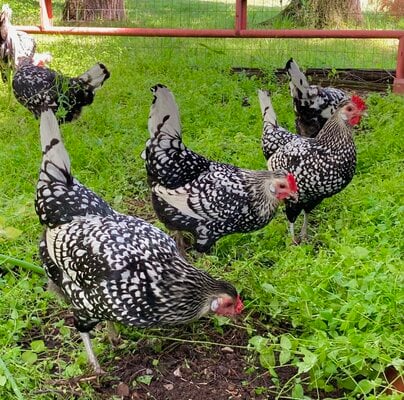MrFarmboy1888
In the Brooder
- Aug 27, 2023
- 12
- 29
- 46
So, here in kansas, and surrounding Midwest region, we have Heat often hotter than Florida, and Cold often colder than coastal places further north. I have seen 110F and -10F.
So, first, on existing breeds that are hardy for both extremes, for me the Americana has been pretty resilient, for instance the Buff Orphington seems to suffer more in both summer and winter.
The mediterranean breeds seem to take heat better, and I am thinking the majority of the cause of that is body type since they take heat even with dubbed combs which help them take cold beter if they do not have a comb to freeze.
So, I am thinking add some Mediterranian body type to Chantecler comb for a Midwest hardy dual purpose breed, select for hardiness for 6 generations.
Whiting True Blue should be very Midwest Hardy if my theory is correct.
Some cross ideas to create a new bred that lays good, still has some meat potential, and is heat and cold hardy:
1) Buff Catalana or Buff Minorca to buff Chantecler.
2) Brown Leghorn to Partridge Chantecler.
3) White Leghorn or White Minorca to White Chantecler.
4) Red Leghorn to Buckeye.
---
For disease resistance could cross some Kraienkoppe or Cubalaya or Fayoumi into the breed, which should also help some for heat.
Thoughts and ideas?
Or experiences with such crosses and their heat/cold hardiness?
So, first, on existing breeds that are hardy for both extremes, for me the Americana has been pretty resilient, for instance the Buff Orphington seems to suffer more in both summer and winter.
The mediterranean breeds seem to take heat better, and I am thinking the majority of the cause of that is body type since they take heat even with dubbed combs which help them take cold beter if they do not have a comb to freeze.
So, I am thinking add some Mediterranian body type to Chantecler comb for a Midwest hardy dual purpose breed, select for hardiness for 6 generations.
Whiting True Blue should be very Midwest Hardy if my theory is correct.
Some cross ideas to create a new bred that lays good, still has some meat potential, and is heat and cold hardy:
1) Buff Catalana or Buff Minorca to buff Chantecler.
2) Brown Leghorn to Partridge Chantecler.
3) White Leghorn or White Minorca to White Chantecler.
4) Red Leghorn to Buckeye.
---
For disease resistance could cross some Kraienkoppe or Cubalaya or Fayoumi into the breed, which should also help some for heat.
Thoughts and ideas?
Or experiences with such crosses and their heat/cold hardiness?






